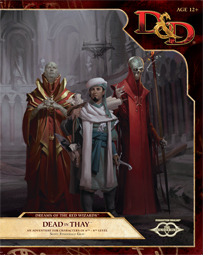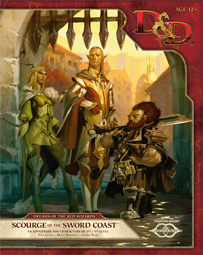![]()
 How much monster culture, history, strengths and weaknesses should be divulged to the player characters? What’s common knowledge, what’s within reach and what’s impossible to unearth?
How much monster culture, history, strengths and weaknesses should be divulged to the player characters? What’s common knowledge, what’s within reach and what’s impossible to unearth?
Player characters’ degree of monster knowledge has always been a touchy subject throughout D&D’s editions as it directly impacts the atmosphere of the adventures, the pace of the game session and the ability of characters to more soundly and quickly triumph over monsters, in and out of combat.
While 4e moved towards a more skill-specific and encyclopedic approach, the D&D Next playtest materials have covered the entire spectrum on monster knowledge. By the final playtest packet, the rules were quiet on the subject, if not more organic.
“What do we know about this monster?” It seems a question best left to DMs to answer based on their campaign world and play style preferences. With D&D 5e’s modular complexity, that may just be the best solution.
But is there a best approach? What are the pros and cons? Here are five key questions to consider when deciding how to handle monster knowledge checks in your games. We start by channeling Leonine Roar’s all-time most popular article in question #1:
1) Can They Identify the Monsters?
“What the hell are you?!”
First, can the PCs even identify the monsters? Especially ones their characters have never faced?
One thing that’s been lost recently is physical and thematic monster descriptions, such as the italics text openers in the 3.x Monster Manual. Those are great mood-setters, creating that classic feel of monster dread. Why would you skip this brief and engaging storytelling opportunity and simply tell the PCs exactly what they’re facing from the jump?
What does it freaking look like? Give me a real damn description. Details. Eyes color and shape, hair style and color, tattoos, scars, its gait, its muscles, its stench, its face and facial expressions – for starters. Go five senses, damn it. Make me feel like it’s an actual monster just through show-and-tell! You know, how a novelist who cares meets a movie director who cares. So, given a real honest-to-goodness description, would the PCs even know they’re fighting a zombie vs. a ghoul vs. a ghast vs. a new, similar undead breed of your creation?
Maybe. Some monsters are so ubiquitous, like zombies and skeletons, you can call them that or describe them as that, without actually saying what they are. (You also have the annoying veteran player vs. newer player knowledge thing working here. Vets know classic D&D monsters, and many less-classic ones, so these players are a little harder surprise over time.) But maybe you have no idea that’s a ghoul or mummy – especially if you don’t care to ask and are subconsciously simply enjoying the horror of what it might be or not knowing what it is really is. Surprise and flavor for the win! (More on this in #3.)
Unless you’re fighting zombie or orc #100, it’s best to describe most monsters first rather than just naming them outright. Let the party figure out, or better yet, assume, what they’re fighting is in fact, a zombie or orc, instead of what it really is – they’ll be right often, and in suspense or surprised the other times.
2) How Much do They Know?
“There’s *how much* lore?”
What types of monster knowledge do the PCs know? How much of each of culture, history and typical disposition; combat abilities and preferred tactics; combat strengths and weaknesses? The last two have a potential to be both time consuming and surprise- or flavor-crushing.
The true lore (culture, history, ecology, psychology, attitudes, behavior, alignment, willingness to talk vs. fight, etc.) is critically flavorful and adds more rich believability to your world. It encourages more creative solutions to challenges from the PCs, rather than simply “it’s evil, kill it” at every turn. Hell, even Dean Winchester eventually figured out the world of monsters wasn’t black and white, making him an even more believable, compelling and complex character in one tremendous series.
The big challenge with all that rich lore is volume: all that flavor may be awesome, but it’s hard to transform it into three succinct bullets in three seconds to keep the combat or adventure moving. Skim the information, root out the highlights, and divide and share them based on DCs and ability checks. You’ll inevitably have to do plenty of this on the fly, but you can always save some time by bookmarking your favorite or “coming soon” monsters and enemies between sessions.
As for combat-related knowledge, remember that it’s monster kryptonite. It’s the mace of disruption to your undead host. It’s a cool button, but it’s also an easy button. (More on this in #5.)
Since great power often comes with reams of text and paperwork, keep the combat-related knowledge to high DCs and even then, give them brief information without going too much into numbers, mechanics or even the proper name of the ability. Otherwise it’ll feel like pulling public records and DNA files while crashing into a vat of calculus. Pace-killer, +9, anyone?
 3) When Do They Know?
3) When Do They Know?
“When did you figure that out?”
Timing is monstrous. When do the characters know about the monsters? Automatically and instantly or only when they ask? This is another tough decision.
Do you automatically bog down the game and disrupt the fast flow of each combat to go Wikipedia on the party’s ass? In other words, do you freely volunteer monster knowledge – either in one lump sum or scattered in bits throughout a sequence or in a combat, perhaps once a round – a clue or tidbit as you go? Or do you just shut your trap as DM and only give out monster knowledge when the party cares enough to ask, concentrating on the other forty-two bazillion things you’re doing as DM?
While it’s fun to throw in tidbits so they learn “who they’re really fighting” and it amps up the atmosphere, keep it to a light seasoning throughout combat, in tiny doses. Only go Reasonably Sized Grand History of the Realms on them if they yell “What the #$%! is this thing?” or “How do we kill it?” Arnold-style and specifically ask about any known weaknesses.
4) What Knowledge is Critical?
“How do we kill it?”
Great power doesn’t just come with the possibility of Candlekeep collapsing onto your game table. Knowing the critical strengths and weaknesses of monsters also comes with great repercussions.
Ask yourself if the characters could possibly know the critical strengths and critical weaknesses or “hard counters” of a monster. Keep both very difficult to reach. Where’s the mystery and challenge otherwise?
For example, knowing a mummy is vulnerable to fire and that a remove curse spell solves their mummy rot curse are both critical weaknesses. Easy button knowledge demands the highest of DCs: 20 or more. This knowledge is a game-changer, just like a critical hit. So like crits, keep it special, exciting, rare and powerful. Otherwise the party will feel like a bunch of cyborg assassins plugged into Google Glass and All the Secrets of the Universe 24/7. No one’s that smart. Yet.
Critical strengths like undead immunities are best at medium or high DCs. Not all of these are game-breaking enough to throw them all into the high (20) DC bin. Use your judgement and moderate (15) DCs for certain critical strengths that feel ubiquitous or not purely tactical in nature – for example, not needing to eat, sleep or breathe.
5) When is Knowledge Easier or Harder to Get?
“I don’t know, but it’s not from here… and it’s extremely powerful…”
Finally, is monster knowledge a moving target? Should DC 10, 15 and 20 always yield some monstrous amount of information?
Consider the ubiquity of the monster as well as the monster’s level and origin. For examples, zombies and skeletons are everywhere as common low level undead, easily described and identifiable. However, many demons are high-level and not all are as famous (to players at least) as a pit field or balor.
So while you might set identity / typical disposition (some combination of their alignment and what motivates them to fight, flight or parley) / undead immunities for zombies and skeletons at DCs 10/15/20, a marilith demon’s identity / disposition / weaknesses might be DC 15/20/25, with DC 10 giving the characters nothing. The DCs essentially move up or scale with the creature’s power, rarity and otherworldly or obscure origin.
D&D 5e Monster Knowledge and Beyond
What will monster knowledge look and feel like in D&D 5e in 2014 and beyond? How will it compare to how your playgroup or mine handles it today in Murder in Baldur’s Gate, Legacy of the Crystal Shard or Dreams of the Red Wizards?
My expectation is they keep a quiet, organic approach as core and provide guidelines like those above on adjusting this particular “dial,” just as they’re doing with many other parts of the new Dungeons & Dragons game.
Until then, keep your monsters monstrous and only carefully dare divulge their secrets!
Want more monster design and efficiency advice? Check out the Faster Combat course and ebook.
